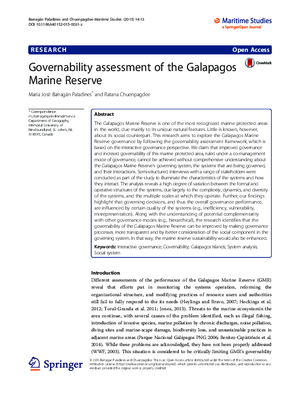Assessment of Recreational Fishery in the Galapagos Marine Reserve: Failures and Opportunities

This research aims to explore the Galapagos Marine Reserve governance by following the governability assessment framework, which is based on the interactive governance perspective.
Key points in document
- The paper assesses a recreational fishery called “Pesca Artesanal Vivencial” (PAV) in Galapagos Marine Reserve. The fishery is an ecotourism project where local fishers take tourists on their boats to experience an “authentic day at sea.”
- The research examines the problems associated with the PAV implementation and offers suggestions to improve the project’s sustainability.
- Originally, PAV targeted local fishers. Tourism agencies have since introduced common sport fishing tourism to the region under the PAV approach, outcompeting local fishers and shifting benefits away from the community.
- Though the tourism agency version of PAV may provide other tourism related benefits (e.g., profit for restaurants, hotels, or souvenir shops), these benefits are not reaching the target population: the fishers. If the fishers are not receiving benefits from tourism, they continue unsustainable fishing practices.
- PAV, done under its original intentions, is a promising approach which offers an alternative livelihood that maintains the aspect of fishing, aligning to the preferences of the local fishermen, without overexploiting fisheries. Furthermore, PAV builds upon the skills already within the fisher’s repertoire.
Information relevant to Learning Questions:
Are enabling conditions in place to support a sustainable enterprise?
- Participants’ Livelihood Needs are Met: stakeholder alignment, diversification
- Market demand, profit potential, access to credit/capital
- Ownership, governance
- Policies for enterprises, business alliances
- Technical capacity
- Equipment
- Benefit sharing, targeted participants, biodiversity linkage, policies for and enforcement of resource use
Does the enterprise lead to benefits to stakeholders?
- Increased income for participants
Do the benefits lead to positive changes in attitudes and behavior?
- Behaviors regarding sustainable use of resources
Does a change in stakeholders’ behaviors lead to a reduction to threats to biodiversity (or restoration)?
- Biological resource use
Does a reduction in threats (or restoration) lead to conservation?
- Marine ecosystems
- Species

